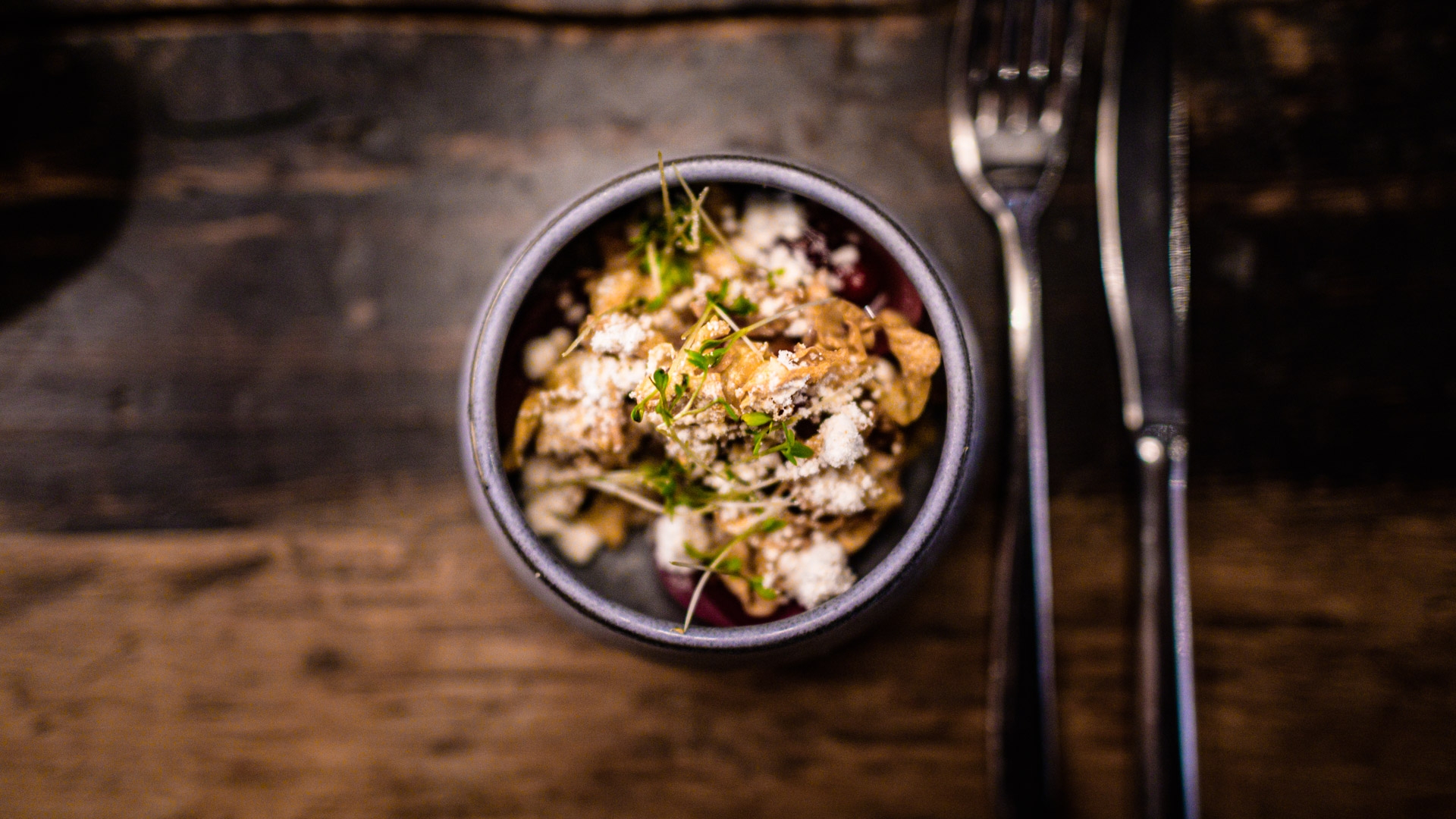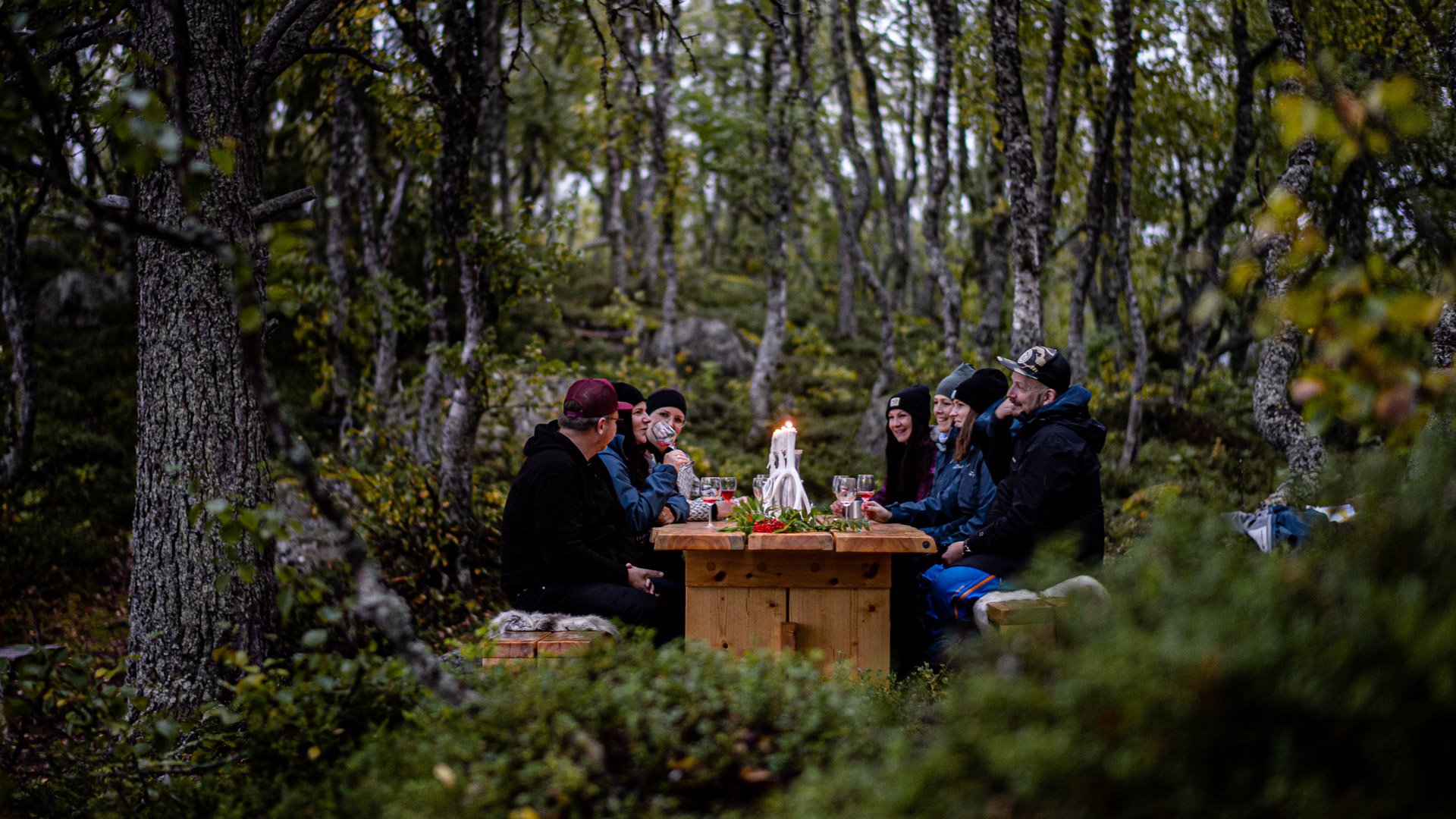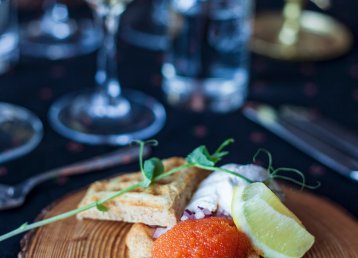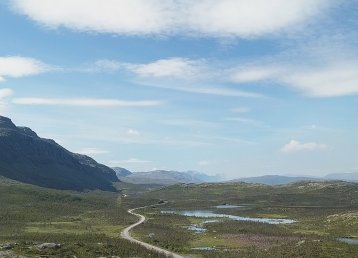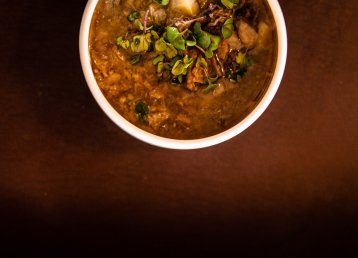Filleting fish by a lake called Sårgåjávrre stand Lennart Pittja and chef Johan Eriksson. The morning’s catch will be just enough for the evening meal. A fire has been lit in the old smoking hut. This is Lennart’s place. Here, his reindeer-herding family has had a home and a livelihood as long as anyone can remember, and they were able to build a boat.
Fresh fish straight from the lake, a little salt and a smoker and the fish will be warm in a couple of hours. On the face of it, that doesn’t sound so remarkable. Even so, that’s about as simple and good as food can ever be. Pure. Local. Arctic. That’s pretty much what it was all about when the Nordic noir food trend went international. Fresh ingredients prepared and preserved according to ancient methods that were practised by the original inhabitants of the region: smoked, salted, pickled or dried and, most of all, fresh and right on location. So, if the new Nordic cuisine wants to call itself progressive, Swedish Lapland can rightfully claim that it has been that way for 6,000 years or more. We have never known anything else.
The star chef
Acclaimed restaurant Oaxen in Stockholm, with head chef Johan Eriksson from Piteå at the helm, was awarded its second Michelin star in 2015. The champagne corks hit the ceiling for an evening, and then it’s time to continue with simmering stockpots and low-and-slow cooking. Johan was the head chef when Oaxen won its first star and its second. A colleague says, jokingly, that they will soon be grasping the Holy Grail for Swedish fine dining establishments – an elusive third star in the Michelin Guide. Johan squirms a bit. He’s a little tired of that whole scene. He’s nearly going mad; he never has time to go fishing.
Fast forward a couple of years. Johan Eriksson has opened a new restaurant, called Centrum Krog, in the middle of Piteå. He says it’s a modern bistro, and when asked about his food philosophy, he just looks at me and says:
– It’s pretty and simple, and darn good.
Before opening Centrum Krog, the Michelin star chef had a stunt at a pizzeria, Kiosken Pizza och Vin located a stone’s throw away at Pensionatet in Piteå. In the world of food, the pizzeria is the final outpost of democracy. Without the local pizzeria, many parts in Sweden would have no restaurant at all. A Vesuvio pizza in Swedish Lapland and a Vesuvio in the south of Sweden barely differs. However, it goes without saying that Johan Eriksson’s pizzas were not of the run-of-the-mill reformed ham variety. The talent for good cooking never leaves someone who has led a two-starred Michelin kitchen. This was a pizza for all true food lovers. But more important than that, it gave him time to go fishing. At ten on any given night, when he’s managed the last order and the kitchen is about to close, Johan knows his car is packed and ready, and a couple of fishing rods sits on top of his gear. In a few hours, he’ll be on the river.
Sweden’s best sommelier
Loving food and drink have become easier, also in Sweden’s Arctic destination. The town of Luleå has no fewer than six restaurants in the Swedish White Guide, all within a stone’s throw from each other. Microbreweries, White Guide eateries and Sweden’s best sommelier, in the country’s most beautiful hotel, is something to look forward to on a moveable feast.
But what does it take to be Sweden’s best sommelier? One way is to quit high school, take a job in a ski resort and ski your buns off while devouring as much wine knowledge as you can. Then, as an autodidact, you might just have a chance to be the first wine aficionado to become Sweden’s Sommelier of the Year twice. For Patrik “Strumpan” Strömsten that was the career path. And, along the way, a hotel came into the equation. Currently, he and his good friend Johan “Jossi” Lindblom run Niehku Mountain Villa in Riksgränsen, in the Kiruna mountains. Their hotel won UNESCO’s Prix Versailles for the world’s best hotel interior. The kitchen serves world-class food, but its most impressive feature is a wine cellar extraordinaire. We follow Strumpan down to what was once a railway roundhouse pit but is now a wine cellar with a glass ceiling. He stops in front of several cases of “Phenomena”, a Brunello di Montalcino by Giugi Sesti.
– The last time I visited Sesti, Keith Richards was sitting at the breakfast table. I thought, ‘don’t I recognise that man from somewhere?’ It took me a while before the penny dropped. Keith has been drinking Sesti’s wine for as long as the old astronomer has been making it. Always organic and harvested according to the phases of the moon.
It occurs to me that wine, like rock’ n’ roll, has a way of bringing people together. An old ski bum and a legendary guitar player, enjoying the first espresso of the day in a remote corner of Tuscany. Strumpan’s journey and Niehku’s success are somehow synonymous with the evolution of good food and drink. You start with something that interests you deeply and turn into something phenomenal, whether it has to do with a keen interest in wine, a sense of how one’s very own beer should be brewed or how long it takes to smoke a fish to perfection.
Also read
Living in a dreamThe Icelandic chefs in Skellefteå
A couple of days after meeting Strumpan in Riksgränsen I enjoy a ten-course tasting menu at Bryggargatan in Skellefteå. It is a gastronomic experience conjured up by Icelandic chefs Jon Oskar Arnason and Runar Larsen. Excellent fish with a hint of liquorice, a passion they brought with them from the island in the Atlantic. Before the two Icelanders came to Skellefteå the town was well known for its hockey team, but scarcely for its food. On a dismal square, people might have been heard arguing over who made the best kebab. Back then, the speciality wasn’t exactly sirloin of reindeer and deep-fried gnocchi.
– The food culture didn’t bring us here. But Bryggargatan promised a great possibility, says Runar.
– And the town is surrounded by nature. I pick wild mushrooms, and I hunt. I try to get out as often as I can. Perhaps it’s what really makes me love this place, says Jon Oskar.
The evening’s ten-course menu is rounded off with a dessert complemented by an exquisite piece of Svedjan cheese, a favourite from the village Storkågeträsk.
– Over the past decade, attitudes to food have changed, but not only eating, producing as well. We are in the middle of cheese country, and we have always had our fantastic Västerbotten cheese.
– That a couple like Johanna and Pär Hällström at Svedjan Ost would suddenly appear on the scene and be asked to make cheeses for the Nobel banquet was unexpected although very cool.
– Someone has to depart from convention and lead the way, as always.
Cheese made just right
In Storkågeträsk the cows are still out to pasture. But their freedom to graze all summer long and well into the mild autumn will soon end when the days grow short, and the northern winter comes.
– Quite simply, healthy animals produce the best food, says Pär, looking out over the golden meadow down by the lake.
– We started making cheese because we wanted our cows to have a good life. We wanted to preserve a living landscape and keep animals that are healthy and content, but it was hard to make a living by just producing milk. So, one day we decided to try making cheese instead. But there’s not much money in making cheese either. Timewise, it’s a long-term investment.
Svedjans Gårdsost, a grainy hard cheese for which Svedjan has won numerous awards, must be aged for at least a year before it is “just right”. And when you are new to making cheese, how can you know what “just right” is? Pär now has a pretty good idea of what constitutes a good cheese. It has to be just how he likes it. When he and Johanna began their dairy-farming transition, he had only one thought in mind – but he couldn’t be entirely sure until he had reached his goal.
Today Svedjan markets three kinds of cheese, they run a summer café, and they have relied on a few pigs to take care of by-products from cheese production during the summer. The pork is cured and served as lardons at Bryggargatan.
– The great thing is that we’re not alone in all of this. There is a growing interest among those who wish to eat well and locally, which means that Skellefteå can have restaurants like Bryggargatan and Luleå can have places like Restaurang CG and Hemmagastronomi. And there are more and better producers. When I was at Mathantverks-SM (Sweden’s national championship for artisan food) a few years ago, I stood quite close to my cousin, Anders Skum from Fjällvilt in Ammarnäs, explains Pär, adding:
– We both went home with awards.
The Sámi kitchen
Swedish Lapland or Sweden’s Arctic region can scarcely be mentioned in a culinary context without a hats-off to the Sámi kitchen. Unlike the mass-produced kind you find in a supermarket, Anders Skum’s renskav (thin-sliced reindeer meat) is hand-cut with a knife.
– When we decided to sell renskav and suovas, using a machine to process, it was out of the question. The meat must be cut in thin slices, just as we prepare it. It should feel as if the meat has been thawed to just the right degree and then perfectly sliced.
In the Sámi language “perfectly thawed” translates as surmmit, a word for when the sun melts the hard crust overlying the snow just enough to give the ideal surface for skiing. The Sámi have about two hundred words for snow. But to describe perfectly smoked reindeer meat, the word suovas suffices.
Also read
Sápmi slow foodThe edible country
Twenty-five kilometres beyond the end of the road, on an island in a lake called Sårgåjávrre, about as far away as you can get from what we might call civilised Sweden, sits guide Lennart Pittja and chef Johan Eriksson eating freshly smoked Arctic char and newly baked gáhkku. This Sámi flatbread is a bit similar to Indian chapati or Persian pita.
– This is so darn good, Lennart.
– Incredibly damned good, says the once Michelin-starred chef in between the bites.
– Well, that’s very cool coming from you, says Lennart with a smile.
But seriously, this is exactly how food should taste. Real, fresh and just as nature intended. And even better, since we caught it ourselves.
By Sårgåjávrre, in the wee hours, as one day merges with the next under the midnight sun, a guide and a chef sit talking about food. In a couple of hours, they will go out fishing. Tomorrow, too, they must have something to eat.
The taste of Swedish Lapland
With about 100 days of midnight light we get the best grass, which makes the best forage and the best food. We think of our food as pure, local and Arctic.






















